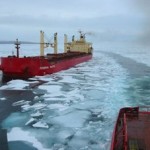
New York – Investing around US$8 billion a year in rebuilding and greening the world’s fisheries could raise catches to 112 million tonnes annually while triggering benefits to industry, consumers and the global economy totaling US$1.7 trillion over the next 40 years.
These are among the findings of a new, landmark report being compiled by the United Nations Environment Programme (UNEP) and economists entitled the ‘Green Economy’ – part of which was previewed on May 17 in New York.
The investment, some of which can be covered by phasing down or phasing out some of the US$27 billion-worth of fishing subsides currently in place, is needed to dramatically reduce the excess capacity of the world’s fishing fleets while supporting workers in alternative livelihoods.
Funding is also required to reform and re-focus fisheries management, including through policies such as tradable quotas and the establishment of Marine Protected Areas, in order to allow depleted stocks to recover and grow.
Such measures, backed up by bold and forward-looking investments, would not only generate important economic and environmental returns, they would also assist in fighting poverty by securing a primary source of protein for close to one billion people.
Achim Steiner, UN Under-Secretary General and UNEP Executive Director, said, “Fisheries across the world are being plundered, or exploited at unsustainable rates. It is a failure of management of what will prove to be monumental proportions unless addressed.”
“The lives and livelihoods of over half a billion people, linked with the health of this industry, will depend on the tough but also transformational choices Governments make now and over the years to come,” he added.
“The Green Economy preview report presented offers a way of maximizing the economic, social and environmental returns from rebuilding, reforming and sustaining fisheries for current and future generations. The scenarios recognize that millions of fishers will need support in retraining and that fishing fleets must shrink. But this needs to be set against a rise in catches, an overall climb in incomes for coastal communities and companies, improvements in the health of the marine environment and ultimately hundreds of millions of people whose incomes and livelihoods are linked to fishing,” he added.
The final Green Economy report, which will cover 11 sectors from agriculture and waste to cities and tourism, will be published in late 2010. The preview, launched during the meeting of the Preparatory Committee for the Rio+20 meeting in Brazil in 2012, covers marine fisheries, water and transport.

Fisheries – Facts & Figures
- It is estimated that there are currently 35 million fishers and more than 20 million boats actively engaged in fishing.
- Fisheries directly and indirectly support 170 million jobs and US$35 billion in incomes to fishing households annually.
- If post-fishing activities are factored in, along with an assumption that one fisher has three dependents, then about 520 million people or eight per cent of the global population are supported by fisheries.
- Mismanagement, lack of enforcement and subsidies totaling over US$27 billion annually have left close to 30 per cent of fish stocks classed as “collapsed” – in other words – yielding less than 10 per cent of their former potential.
- Only around 25 per cent of commercial stocks – mostly of low-priced species – are considered to be in a healthy or reasonably healthy state.
- On current trends, some researchers estimate that virtually all commercial fisheries will have collapsed by 2050 unless urgent action is taken to bring far more intelligent management to fisheries north and south.
The report estimates that of the US$27 billion-worth of subsidies, only around US$8 billion can be classed as ‘good’ with the rest classed as ‘bad’ and ‘ugly’ as they contribute to over-exploitation of stocks.
Fisheries – A Green Economy Strategy
Under a Green Economy response, aimed at reducing the global fishing effort to a ‘maximum sustainable yield’, an estimated reduction of excess capacity is required, because current capacity is 1.8 to 2.8 times what is needed.
These reductions could be achieved through careful targeting of the most ecologically damaging surplus capacity, so that of the estimated 20 million vessels and 35 million fishers deployed in this sector, the livelihoods of those that are artisanal and poor are treated equitably.
The report estimates that an investment of between US$220 to US$320 billion world-wide is required and equal to around US$8 billion a year but that this investment would:
- Raise total income of fishing households, including those engaged in artisanal fishing, from US$35 billion to around US$44 billion a year;
- Increase annual profits for fishing enterprises from US$8 billion to US$11 billion annually;
- Increase the marine fisheries catch from about 80 million tonnes to 112 million tonnes a year worth US$119 billion annually versus the current US$85 billion.
“Discounting this flow of benefit over time at three per cent and five per cent real discount rates, gives a present value of benefit from greening the fishing sector of US$1.05 trillion and US$1.76 trillion, which is three to five times the high-end estimate of US$320 billion as the cost of greening global fisheries,” says the preview report.












